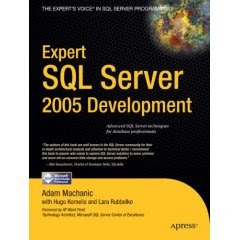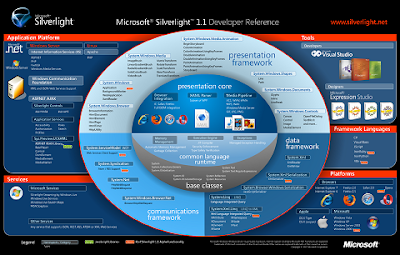
I am a big fan of Adam Machanic and the way he thinks about SQL server development. How may SQL developers unit test their procedures or use assertions in their code? Well I can guarantee that there are very few of those. I was very excited when Adam Machanic contacted me to give me a copy of
Expert SQL Server 2005 Development
for review. I did not finish reading the whole book yet but what I have read so far is very good. If you are an advanced developer and want to kick it up a notch then this is the book for you.
The question-and-answer session with Adam that follows was conducted via email.
What is the audience for this book? Is the book geared towards a beginner/intermediate level user or do you have to be an advanced user to really utilize the information in this book?
The book is certainly not for beginners; I make a lot of assumptions about the level of knowledge possessed by the reader. The reader should understand the basics of writing T-SQL, creating indexes, reading query plans, etc. It's difficult to differentiate between intermediate and advanced users, as everyone has their own opinion of what those levels actually mean! I've covered several not-so-common topics, and my hope is that that almost any SQL Server practitioner who has advanced beyond the basics can learn something from the book.
What are the most important things a person can do to master Transact-SQL?Practice, practice, and more practice! The more complex queries you write, and the greater the variety of problems you solve in T-SQL, the easier it gets. Just like other programming languages, T-SQL programmers use and reuse various patterns as they work on different projects and problems. Gaining skill in T-SQL is really nothing more than a process of learning when and how to properly apply the patterns to any given situation.
Adam, the first time I came across your name was in the Microsoft public SQL Server programming group. Can you explain to us why you participate in newsgroups and forums?When I first started working with SQL Server and other Microsoft technologies I discovered Microsoft's news server and was shocked to discover the overall quality and high signal-to-noise ratio compared to many other (Usenet) newsgroups I'd previously frequented. Questions I asked were actually answered--by people who knew what they were talking about, no less! After spending quite some time asking my own questions I realized I could answer a few here and there too, and give something back to the community that had helped me so much. Over time I became hooked. What a great way to kill free time (especially while waiting for software to compile or long queries to run)--not only does it feel good to help others solve their problems, but it also helps to strengthen my skills as a developer. As I mentioned in the previous question, the most important key to software development greatness is practice. By answering newsgroup and forum posts, you can get exposure to all sorts of business problems and scenarios that you would otherwise never see. There is no better learning experience that I have found.
Why is it important to think in sets instead of procedurally?
It's often said that thinking in sets takes advantage of the declarative nature of SQL; and while this is certainly true I think it's important to drill down to why that's such a big deal. SQL query performance, generally speaking, comes down to I/O performance. Too many I/Os, or an I/O-bound system, and your query won't return fast enough--simple as that. When we write set-based queries, we allow the query engine to optimize in order to minimize the number of index requests--and, therefore, I/O operations--necessary to satisfy the query. Working procedurally, with loops, means that the opposite happens--the maximum number of index operations will happen on every invocation, and therefore the query will perform in constant time—at the worst possible level.
Why do you feel it is important to properly unit test procedures?
I cover unit testing in some detail in Chapter 2 of the book, including when and why you want to do it. But what it boils down to is that creating a solid unit test infrastructure helps to guarantee that as you change your code over time, you won't break anything--and if you do, you'll find out about it very quickly. Studies have shown that by far the most expensive part of the software development process is maintenance. This is due to the fact that as we change our software, we break other pieces (dependencies)--and oftentimes, those dependency breaks silently cause subtle issues, that aren't noticed until long after the change was actually made. This can make it extremely difficult to track down and fix the root causes of problems. Comprehensive unit testing makes it possible to eliminate a lot of that delay, by alerting the developer right away if something doesn't look good. This, in turn, results in better quality software, happier customers, more business, and as a result, bigger bonus checks. A win-win situation, if you ask me.
Which chapter was the hardest to write and can you explain why?Chapter 10, "Working with Temporal Data," took me four months to write. It's my favorite chapter in the book, and one of my favorite topics to think about, but it covers a huge variety of scenarios. As I mention in the chapter, temporal data finds its way into every single database, so it's a large and far-reaching topic. Attempting to cover it in a fairly complete manner turned out to be quite a big task!
Why do you write technical books?Mainly for the groupies. But aside from that obvious perk, I do it simply because I love sharing technology and techniques with others. Writing a book is similar to participating in a newsgroup or technical forum, but on a much deeper level. Whereas I might answer a question on a forum in 400 words, or write a 3,000-word article, in a book I can cover the same topic in 15,000 or more words--really guide the reader through all of the pitfalls and ins and outs of a given area, and do things that would be impossible in another media (except, perhaps, in a long series of blog posts or articles). Plus, let's be honest--it's just a real thrill seeing my name on the cover of a book!
Who are your favorite authors?
For technical titles, my favorites are Steve McConnell ("Code Complete," "Rapid Development"), Joe Celko ("SQL For Smarties" and others), and Andrew Troelsen ("Pro C# and the .NET Platform"). These authors manage to convey heavy technical topics in very readable formats--which is something I aspire to doing in my own writing.
Unfortunately, I haven't been reading much fiction recently. The last really great novel I read was "Cloud Atlas" by David Mitchell. I'm also a longtime fan of science fiction writers such as William Gibson ("Neuromancer") and Neil Stephenson ("Snow Crash," "Cryptonomicon").
I noticed you have a chapter that deals with application concurrency, do you feel that developers don't have a multi-user/multi-app mindset when first developing the data model/procedures?With the recent trend towards multiprocessor and multicore machines, threading and synchronization have been hot topics. I've read lots of interviews and articles about how many developers don't understand multithreading well enough. Yet as database developers, I feel like we've been there for years--the database is almost always a shared resource, and managing synchronization is no less important there than in the application tier. A lot of the time we tend to think about concurrency merely in the context of isolation levels and the like, but there is a lot more to it than that--an application will often push much of its synchronization logic all the way into the data tier (whether on purpose or not), and how to properly handle things is really more of a business question than a technical one. When writing that chapter, I tried to frame the issues in terms of business requirements, and then show how to use SQL Server to satisfy them. I think that developers are sometimes prone to getting too excited about technology and trying to find a business problem to which they can apply some new technique--the whole "hammer looking for a nail" mentality--rather than the correct route of determining the business problem and then using technology to solve it.
What SQL Server books are on your bookshelf?I've now gotten rid of most of my SQL Server 2000 books, except for Ken Henderson's Guru's Guide" series and Kalen Delaney's "Inside SQL Server 2000". My bookshelves (note the plural!) are filled with SQL Server 2005 books--for the first year or so after its release I managed to get almost every new book that was released. I eventually slowed down a bit, but it's hard--there is a lot of great material out there! I'm a really big fan of the "Rational Guides" -- short, concise, yet in-depth guides to just one topic, generally very well-written and easy to digest.
Why did you decide to include a chapter on spatial data?
Through nothing more than luck of the draw I ended up on a couple of projects involving heavy spatial queries, and found that it was an area I really enjoyed. I love to solve difficult problems, and since comparatively very few people are doing spatial in SQL Server, I found that there was a lot of room to innovate--so I ended up having a great time with these projects and totally got hooked. I feel that spatial data is an area we're going to see a lot more of in the future. Spatially-enabled devices are becoming more and more prevalent, and of course all of those devices are going to need data. Unfortunately, due to time constraints I was not able to write that chapter, so my friend Hugo Kornelis tackled it. Hugo did an absolutely fantastic job of covering the topic--I think it's a great chapter, and will help readers get right up to speed.
Are you still making your own beer?I live in a fairly small apartment at the moment and am somewhat cramped for space as well as time, so I haven't brewed a batch beer for the last couple of years. However, I have been experimenting with ciders quite a bit, and have made a variety of batches using all sorts of adjuncts including honey, brown sugar, and malt extract. Cider is very forgiving and needs to sit around for a long time before it's drinkable, so it's easy to make in a small space with limited time. I've also made a few batches of ginger beer, using a recipe that we actually designed in an online SQL Server forum!
(
http://www.simple-talk.com/community/forums/thread/1232.aspx )
Table Of ContentsCHAPTER 1 Software Development Methodologies for the Database World
CHAPTER 2 Testing Database Routines
CHAPTER 3 Errors and Exceptions
CHAPTER 4 Privilege and Authorization
CHAPTER 5 Encryption
CHAPTER 6 SQLCLR: Architecture and Design Considerations
CHAPTER 7 Dynamic T-SQL
CHAPTER 8 Designing Systems for Application Concurrency
CHAPTER 9 Working with Spatial Data
CHAPTER 10 Working with Temporal Data
CHAPTER 11 Trees, Hierarchies, and Graphs
INDEX
Sample: Chapter: Ch. 01 - Software Development Methodologies for the Database WorldAmazon Link: Expert SQL Server 2005 Development
 I wonder how many trees he killed with all that paper on his desk? He better have solar panels to power those 3 monitors!
I wonder how many trees he killed with all that paper on his desk? He better have solar panels to power those 3 monitors!




